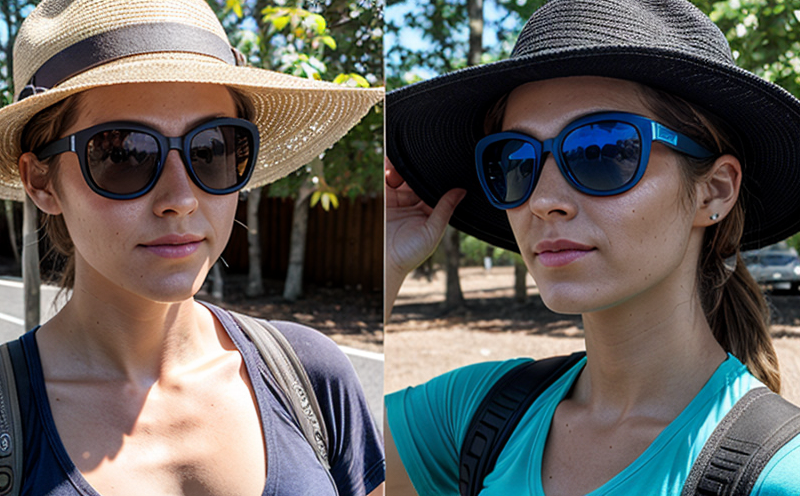GB T 8427 Testing for colour fastness to artificial light Xenon arc
The GB T 8427 test is a critical procedure used in the textile industry to evaluate the resistance of dyed and printed textiles to degradation caused by exposure to artificial light, specifically a Xenon arc lamp. This method simulates the effects of sunlight, including ultraviolet (UV) radiation, which can lead to fading or color changes over time.
This testing is essential for ensuring product quality and durability in various sectors such as fashion, home textiles, automotive upholstery, and outdoor gear. Compliance with this standard ensures that products maintain their aesthetic appeal and functionality throughout the expected lifespan of the item.
The test follows a standardized process where samples are exposed to controlled light conditions over specified durations. The exposure is designed to mimic real-world environmental factors, allowing manufacturers to assess how well their products will hold up under typical usage scenarios.
During testing, textiles undergo rigorous evaluation using an artificial light source that emits broad-spectrum radiation similar to sunlight. This includes UV-A and UV-B rays which are known to contribute significantly to material degradation. The test can also be conducted at different temperatures and humidities depending on the specific requirements of the product being tested.
After exposure, the samples are closely inspected for any changes in color fastness, including fading or loss of original shade. Any alteration from the initial state is quantified and recorded as a measure of the sample's resistance to light-induced deterioration.
The GB T 8427 test provides valuable insights into potential product performance issues before they become evident during end-user use. By identifying these vulnerabilities early in the development process, companies can make informed decisions about material selection, dye formulations, and finishing treatments that enhance both appearance retention and overall product quality.
Understanding the specific requirements of this test is crucial for textile manufacturers who wish to ensure their products meet domestic standards and gain market acceptance. It also plays a vital role in maintaining brand reputation by delivering consistent high-quality products that satisfy consumer expectations regarding colorfastness and longevity.
Why It Matters
- Ensures compliance with international standards for textile quality control.
- Promotes durability and aesthetic appeal of textiles across various applications.
- Aids in the development process by identifying potential issues early on.
- Supports sustainable practices by minimizing waste from unsuitable products.
The importance of GB T 8427 testing cannot be overstated, as it directly impacts both the manufacturing and retail sectors. For manufacturers, this test helps in maintaining consistent product quality while reducing costs associated with premature product failure. On the consumer side, it ensures satisfaction by delivering durable, visually appealing products that meet expectations.
Furthermore, compliance with such tests enhances a company’s reputation within its industry, fostering trust among consumers and partners alike. This transparency regarding product longevity contributes positively to brand image and customer loyalty.
Applied Standards
| Standard Code | Description |
|---|---|
| GB T 8427-2013 | Test methods for color fastness to artificial light - Xenon arc lamp method. |
The GB T 8427 test is based on the international standard GB T 8427-2013, which provides detailed instructions and guidelines for conducting this type of color fastness testing. The standard covers not only the technical aspects but also offers recommendations for sample preparation, exposure conditions, and evaluation methods.
It is important to note that while GB T 8427 focuses primarily on colorfastness under artificial light, it aligns closely with other international standards like ISO 105-A12, which specifies similar procedures but may have slightly different application areas or additional requirements. Understanding these nuances can help textile manufacturers tailor their testing protocols to best suit their product needs.
Customer Impact and Satisfaction
- Enhances product durability through rigorous quality assurance measures.
- Improves customer satisfaction with consistent, high-quality products.
- Promotes brand reputation by delivering reliable performance across all products.
- Reduces complaints and returns related to color fading or loss of quality.
- Increases market competitiveness through superior product offerings.
The implementation of GB T 8427 testing has a direct positive impact on both manufacturers and consumers. For businesses, it translates into increased customer satisfaction and reduced costs associated with handling defective products. From the consumer perspective, it means enjoying products that not only look great but also last longer, thereby enhancing overall value.
Through adherence to these stringent testing protocols, textile companies can build strong relationships with their customers while maintaining a high level of product integrity. This commitment to quality ultimately contributes to greater trust and loyalty within the industry.





